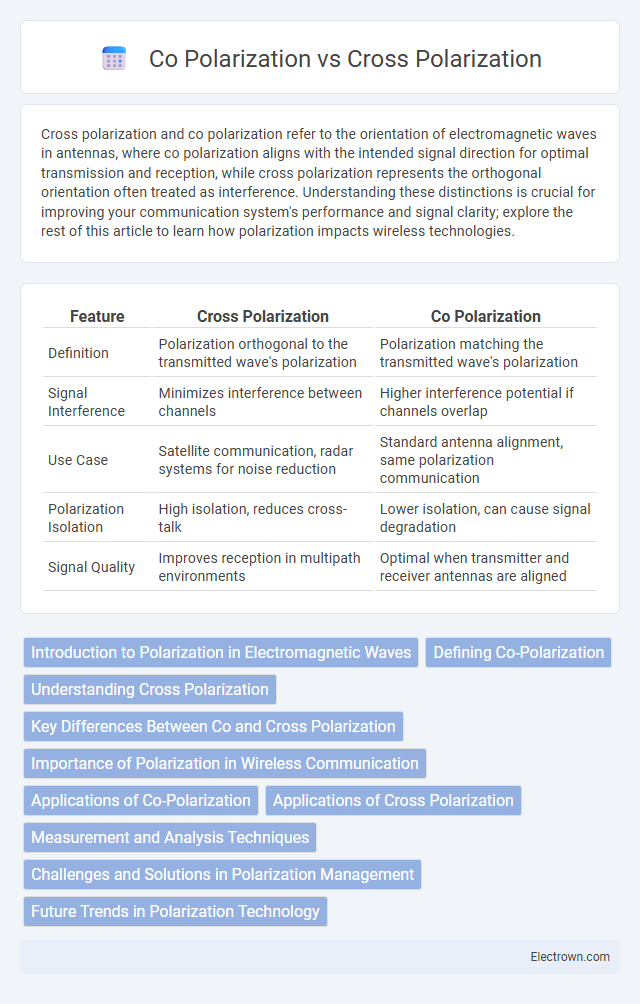Cross polarization and co polarization refer to the orientation of electromagnetic waves in antennas, where co polarization aligns with the intended signal direction for optimal transmission and reception, while cross polarization represents the orthogonal orientation often treated as interference. Understanding these distinctions is crucial for improving your communication system's performance and signal clarity; explore the rest of this article to learn how polarization impacts wireless technologies.
Table of Comparison
| Feature | Cross Polarization | Co Polarization |
|---|---|---|
| Definition | Polarization orthogonal to the transmitted wave's polarization | Polarization matching the transmitted wave's polarization |
| Signal Interference | Minimizes interference between channels | Higher interference potential if channels overlap |
| Use Case | Satellite communication, radar systems for noise reduction | Standard antenna alignment, same polarization communication |
| Polarization Isolation | High isolation, reduces cross-talk | Lower isolation, can cause signal degradation |
| Signal Quality | Improves reception in multipath environments | Optimal when transmitter and receiver antennas are aligned |
Introduction to Polarization in Electromagnetic Waves
Polarization in electromagnetic waves describes the orientation of the electric field vector, with co-polarization referring to the alignment matching the transmitting antenna's polarization, ensuring maximum signal strength. Cross polarization occurs when the received wave's polarization is orthogonal or at an angle to the transmitted wave, often leading to signal degradation and interference. Understanding your system's polarization type is crucial for optimizing antenna design and improving communication quality in wireless networks.
Defining Co-Polarization
Co-polarization refers to the alignment of transmitted and received electromagnetic waves with the same polarization orientation, such as horizontal-horizontal or vertical-vertical. It maximizes signal strength and reduces polarization mismatch losses in wireless communications and radar systems. Clear understanding of co-polarization is essential for optimizing antenna design and improving communication link quality.
Understanding Cross Polarization
Cross polarization occurs when the polarization orientation of the transmitted electromagnetic wave differs from that of the received signal, causing signal degradation due to reduced correlation. It is quantified by the Cross-Polarization Discrimination (XPD) ratio, which measures the power difference between co-polarized and cross-polarized signals. Understanding cross polarization is critical in antenna design and wireless communication systems to minimize interference and optimize signal quality.
Key Differences Between Co and Cross Polarization
Co-polarization refers to the alignment of the transmitted and received electromagnetic waves in the same polarization plane, typically enhancing signal strength and reducing interference in wireless communication systems. Cross-polarization occurs when the transmitted and received waves are orthogonally polarized, often used to minimize crosstalk and improve channel capacity in MIMO (Multiple Input Multiple Output) systems. Key differences include the signal correlation, with co-polarization showing high correlation and cross-polarization providing spatial diversity, impacting system performance and design considerations in antenna and radar applications.
Importance of Polarization in Wireless Communication
Polarization in wireless communication significantly influences signal strength and quality by aligning the electric field orientation of transmitted and received waves. Cross polarization occurs when the transmitted and received wave polarizations are orthogonal, causing polarization mismatch and leading to signal attenuation and increased interference. Co polarization, where wave orientations match, maximizes signal power transfer and reduces error rates, making polarization alignment crucial for enhancing wireless link reliability and efficiency.
Applications of Co-Polarization
Co-polarization is extensively utilized in wireless communication systems such as cellular networks, satellite links, and radar systems where maximizing signal strength and clarity is critical. Applications include antenna design for line-of-sight transmissions, where matching the transmitter and receiver polarization reduces signal loss and enhances data throughput. Co-polarization also plays a vital role in MIMO (Multiple Input Multiple Output) technology, improving channel capacity and spectral efficiency by maintaining polarization alignment.
Applications of Cross Polarization
Cross polarization is extensively used in remote sensing and satellite communication to reduce interference and improve signal clarity by isolating signals with orthogonal polarization states. This technique enhances radar imaging accuracy in meteorology and environmental monitoring by distinguishing between surface types and vegetation. Cross polarization is also critical in microwave and radio frequency systems to enhance channel capacity and reduce multipath fading in wireless communications.
Measurement and Analysis Techniques
Measurement and analysis of cross polarization versus co polarization involve using specialized instruments such as vector network analyzers and polarization analyzers to assess signal properties. Accurate characterization requires capturing parameters like axial ratio, isolation, and polarization purity through techniques including polarization ellipse fitting and Stokes parameter analysis. Your ability to differentiate these polarization components directly impacts the optimization of antenna performance and signal integrity in wireless communication systems.
Challenges and Solutions in Polarization Management
Cross polarization introduces significant challenges in polarization management due to signal degradation and increased interference in wireless communication systems. Solutions include advanced polarization diversity techniques and adaptive polarization control algorithms that dynamically optimize signal alignment to minimize cross-polarization effects. Implementing these methods enhances link reliability and maximizes data throughput in complex propagation environments.
Future Trends in Polarization Technology
Future trends in polarization technology emphasize advancements in cross polarization techniques to enhance signal clarity and reduce interference in wireless communications. Innovations in adaptive polarization systems are enabling more efficient spectrum utilization by dynamically switching between co polarization and cross polarization based on environmental conditions. Your communication systems will benefit from these developments through improved data throughput and more resilient connectivity in diverse propagation scenarios.
Cross Polarization vs Co Polarization Infographic

 electrown.com
electrown.com